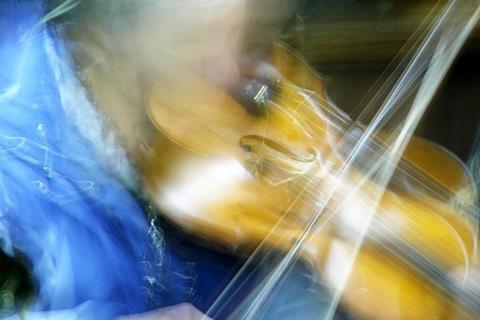Advice on how to be flexible and relaxed as a string player from 120 years of The Strad

The key to mastering the violin is in not allowing unwanted extra physical movements to occur as a knock-on effect or by-product of actions that are actually needed. This includes any unnecessary tension or overwork. Every action must occur in isolation without anything else in the surrounding areas reacting. For example, when you are pressing the bow into the string, do not use a single muscle in your bow arm that is not required to push the wood down towards the hair and to push the hair into the string.
Simon Fischer, The Strad, June 2012
The components of the warm-up should address each hand’s positions and specific tasks. The left hand’s success depends upon a relaxed and balanced grasp of the instrument, elasticity for stretching, finger independence and accuracy, shifting, velocity and vibrato. The right hand’s work begins with reinforced awareness of a balanced bow hold and arm location, and continues with issues of smooth changes in all parts of the bow, control of speed and contact point, string crossings, bowing patterns, distribution, articulations, attacks, releases, dynamic range and tone colour.
Patricia McCarty, The Strad, February 2000
In order that the muscles of the fingers, wrist, and forearm may be properly developed it is absolutely necessary that every portion of the bow should be properly practised. This cannot be accomplished in a few weeks or even a few months – it is a case of growth, and all growth is by nature a somewhat slow process.
Arthur Broadley, The Strad, October 1905
Gentle stretches as a warm up can help, but if they’re not done carefully they can also be counter-productive: a protective mechanism called the stretch reflex will cause the muscle to contract even more in order to prevent any further tearing of tissue. On the other hand, the optimal time to stretch out shortened muscles is while they are still warm, before they have had time to cool down in a contracted state, thus giving them the maximum recovery time in their relaxed position.
David Juritz, The Strad, December 2005
My opinion is that extensions are practicable as long as you release the tension caused by stretching the hand. Once a note has sounded I stop pressing down on the string, releasing the pressure: overtones sound more pleasing to the ear than if you try to maintain the note using force through the finger. Even in extended positions you must consistently let go of tension. Take, for example, a D major scale. I would practise playing the scale slowly, releasing the tension after each finger goes down. I would feel the energy and power in the first-finger D then relax before putting down the second-finger E. The whole hand should be free, flexible and resilient. In facf for me, resiliency and flexibility are the key words.
Cellist Tsuyoshi Tsutsumi, The Strad, December 2003
T’ai chi can be more closely aligned with cello performance than the Alexander Technique because it relies on movement, whereas Alexander Technique tends to have a stationary interpretation. T’ai chi motions are always performed with a fluid, legato movement and can be extremely slow. Try practising bow changes, shifts and whole passages in the same slow way. Determine precisely what motions, adjustments, balances, amounts of bow and finer angles are required to perform a passage of music successfully, then practise the passage very slowly, observing all these elements in a fluid sequence. All unnecessary tension and motion is observed, analysed and eliminated at this stage.

Ross Harbaugh, The Strad, October 2003
The more you bend your head to the left when you play, the sooner you will have shoulder problems. So, if you decide to use a shoulder rest, you should get one that you can regulate. Change the height to extend all the way from the base of the neck to the chin so that you bend your head to the left as little as possible.
Ruggiero Ricci, The Strad, October 2004
Lifting the shoulder to support the violin has the disadvantage of severely limiting the freedom of the left arm and shoulder and of creating potential injury. More often than not, people will be convinced that they are not lifting the shoulder when they are actually doing so. Unreliable sensory appreciation is one of the side effects of poor bodily use. Look in a mirror to see if what you are actually doing matches what you feel you are doing.
Mary McGovern, The Strad, July 1999
When you feel tension or other blockages in your arms, hands or fingers, a multitude of interrelated factors are usually responsible. Many of these factors are subtle or imperceptible aspects of technique that, although seemingly insignificant, set off chain reactions of tension that spread throughout your entire playing. By correcting just one thing, you will prevent all the possible chain reactions that come about because of that action. By not over-pressing your chin into the chin rest, your neck and shoulders will remain free; in turn, they will not reduce the freedom of the upper arms; this then will help to keep the lower arms and hands free; and so on.
Simon Fischer, The Strad, February 2009
Tension comes from within; the desire to ‘get it right’ and to play the music as she hears it in her head can both be big contributors, so making it less important to ‘get it right’ is essential. Try singing at the same time as playing, so that the pupil is focusing more on the music and less on the physical actions. This will help make her body more relaxed.
Jane Cutler, The Strad, January 2015








































No comments yet